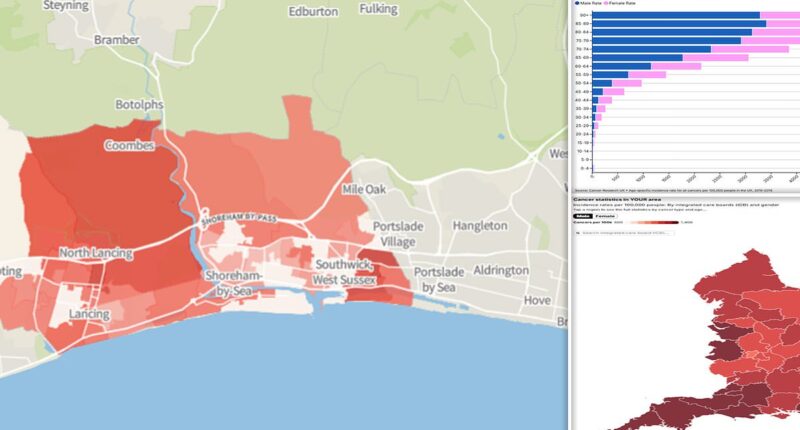
Cancer is the only cause of death in dozens of neighbourhoods in England and Wales, analysis suggests.
MailOnline’s investigation – presented below in an interactive map – analysed every fatality recorded in 2023.
There are 36,000 districts dividing the two nations, making it possible to determine the exact number of cancer-related deaths in your immediate area.
Cancer was responsible for 100 per cent of deaths in 210 unique areas, technically called LSOAs.
These were scattered across parts of London, as well as Cardiff, and further afield in the likes of Wiltshire and Northamptonshire.
In England and Wales, each authority is divided into numerous neighborhoods, typically with around 1,500 residents living just a few streets away from each other.
In total, there are around 36,000 LSOAs.
MailOnline found cancer was responsible for 50 per cent of deaths in 4,679 of the zones, or 13 per cent.
Helen Morgan, who serves as the health and social care spokesperson for the Liberal Democrats, stated to MailOnline that receiving a cancer diagnosis is a challenging ordeal. Initiating treatment promptly is crucial to enhance the chances of survival.
‘But in so many cases people are waiting far too long to be treated, at the mercy of a cancer care postcode lottery.’
She added that the party are calling on the government to publish a ten-year cancer plan to tackle treatment shortfalls.
The Office for National Statistics (ONS) says there were 581,363 deaths logged in England and Wales in 2023.
Alzheimer’s and dementia remained the biggest killers, followed by heart disease.
Covid was not in the top five causes of death for the second year in a row.
Cancer is split into different subtype because there are more than 200 different types of the disease, including bowel, skin, lung, prostate and breast.
One particular zone within the Newlands area of Castle Point, next to Canvey Island, recorded the highest raw number of deaths from cancer.
There, ONS figures show 29 of the 57 deaths that occurred in 2023 were from cancer.
The ONS statistics represent the number of deaths registered in the calendar year 2023.
Because late registrations are common, some data may be missing.
To protect the confidentiality of individuals, the ONS rounds small amounts per area.
It means counts of 0, 1, and 2 are always rounded to 0. Counts of 3, 4, and 5 are rounded to 5.
This could have skewed the findings.
Deaths registered are matched to where the person lived as opposed to where they died, meaning concentrations do not occur around hospitals and hospices.
One in two of us will get cancer at some point in our lives, figures suggest.
Experts have long demanded urgent action to tackle the unfolding catastrophe, calling for a ‘seismic shift in our approach to cancer care’ to save thousands from dying prematurely.
Last week experts warned cancer care in the UK is at ‘breaking point’ and lagging behind other nations because of ‘gross mismanagement’.
Delayed cancer treatment has become ‘the deadly norm’, the leading doctors wrote in The Lancet Oncology. They said no improvements will be made without radical change.
Health Secretary Wes Streeting launched a consultation on a new National Cancer Plan earlier this year, inviting people to contribute their thoughts.
But this followed a similar call for evidence on a ten-year cancer plan by the then health secretary Sajid Javid in February 2022.

















